A cheetah can run up to 120 kph. It runs faster than any other animal on the planet. The acceleration of a cheetah, 0-100 km/h in just three seconds, is just as incredible. It reaches its maximum speed in short bursts.
This special cat doesn’t just run faster than man; it travels faster than almost anything human civilization has ever created.
A cheetah’s acceleration (0-100 km/h) is even quicker than a Ferrari 488 and Porsche 911 GT3.
But there are problems for these incredible animals. Cheetahs have lost 91% of their historical range over the last century. Less than 7000 of them remain.
So how fast does a cheetah run? What is the reason for its speed? And what may the future hold for cheetahs?
Here’s everything you need to know about the speediest African animal there is.
The top speed of a mature cheetah is around 120 kph (roughly 75 mph). It takes a lot of energy to run this fast, so sprinting isn’t a regular part of a cheetah’s day.
A cheetah can reach 120 km/h in a minute. With its slender body and fast-twitch muscle fibers, the cheetah accelerates at 10 meters per second squared.
Within three strides, the spotted hunter has reached 60 mph (96.6 kph). Just let that number sink in – zero to 60 mph in just three strides (around 3-5 seconds)!
Cheetahs reach their maximum speed in 30 seconds. Within half a minute, they may have chased their prey for a kilometer, although 600-700 meters is more common.
After reaching their top speed, cheetahs can cover eight meters in a single stride. During this sprint, there are times when none of the paws touch the ground as they glide effortlessly across the savannah.
Cheetahs can maintain their top speed for about
half a minute.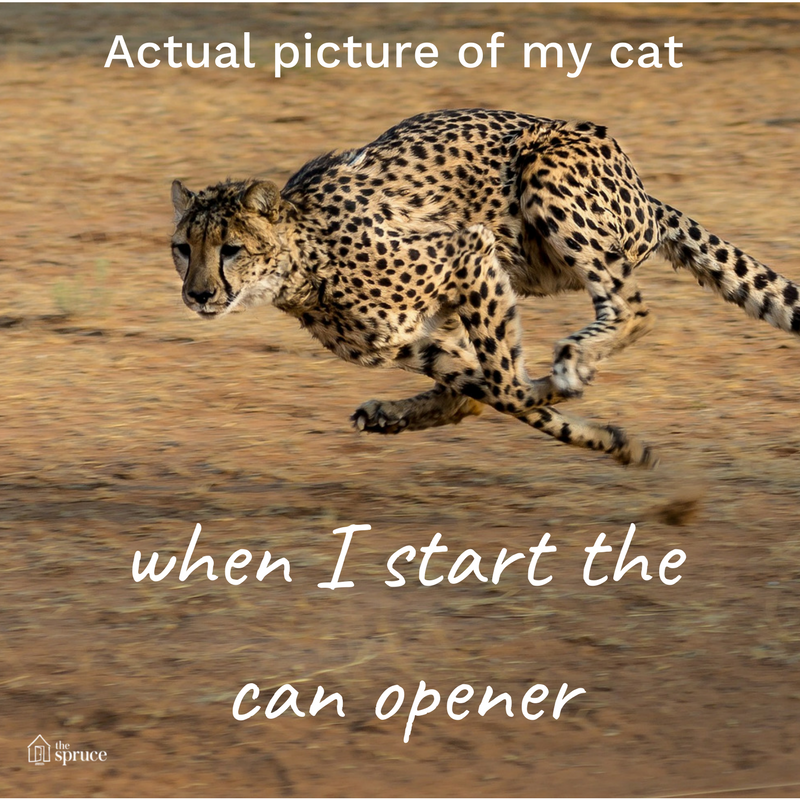 Those 20-30 seconds that a cheetah runs flat out for is all it needs to catch its prey.
Those 20-30 seconds that a cheetah runs flat out for is all it needs to catch its prey.
Cheetahs are small predators. A mature male weighs around 60 kg, which is far less than other cats and most other animals on the savannah. It must be light and slender in order to run fast, with no unnecessary weight.
That piece of science is relatively obvious. You wouldn’t expect a hefty giant like a hippo or elephant to be the world’s fastest animal. The rest of the cheetah science is quite incredible.
The rest of the cheetah science is quite incredible.
It all starts with superb aerodynamics. By minimizing air resistance, cheetahs can slice through a landscape without any drag.
How?
Its head is small and functions in a similar way to how a wing reduces drag on a Formula 1 car.
Their body is very slender, with minimal fat and a flattened rib cage. This shape is similar to the greyhound (the fastest dog there is).
A small head is unusual among big cats. It means a weaker jaw and smaller teeth, so cheetahs are unable to hunt bigger prey.
They can’t fight back against other predators either, so their prey is commonly scavenged by lions and hyenas.
Every good sprinter needs long, strong legs. Cheetahs have the very best, spindly legs with an incredible strength to weight ratio.
Fast-twitch muscles create the acceleration, meaning a cheetah covers six to seven meters with every single stride.
Their gait is similar to that of a galloping horse. When a cheetah runs all four paws come off the ground at once. And here’s the really incredible part. Cheetahs complete three six-meter strides… every single second!
That’s made possible by a cheetah’s greatest asset – its flexible spine.
The spine is like a length of elastic, able to quickly expand then move out of the way so as to maximize how far each leg can swing.
This spine also acts as a spring for the hind legs, coiling and extending with every stride.
When you were a child, did you ever spin a wheel or plate on a stick? You have to touch the plate lightly, so it keeps spinning fast. That’s like a cheetah when its paws touch the ground.
With one delicate and rapid movement, the cheetah can keep accelerating thanks to ridged footpads and non-retractable claws that maximize traction with the savannah.
But how does it keep its balance?
Cheetahs are only around 1. 2 meters long and almost half that length is made up by the tail.
2 meters long and almost half that length is made up by the tail.
When running at such incredible speeds, the tail is like a rudder, used to maintain side-to-side balance. It’s also a counterweight, so the cheetah can throw its weight forward without over-balancing.
Without such a long tail, the cheetah could still run but would spin and crash, like a sports car without a high-quality steering system.
Beneath the compacted rib cage is an oversized heart, capable of delivering vast amounts of blood to the muscles when needed. It’s strong and fast, able to instantly switch from resting to sprinting mode.
Inflated nostrils and large lungs enable cheetahs to gulp in reservoirs of oxygen with a single breath: this is another essential component of their speed.
However, as evolved as they are, it is the heart and lungs that cause most problems for cheetahs.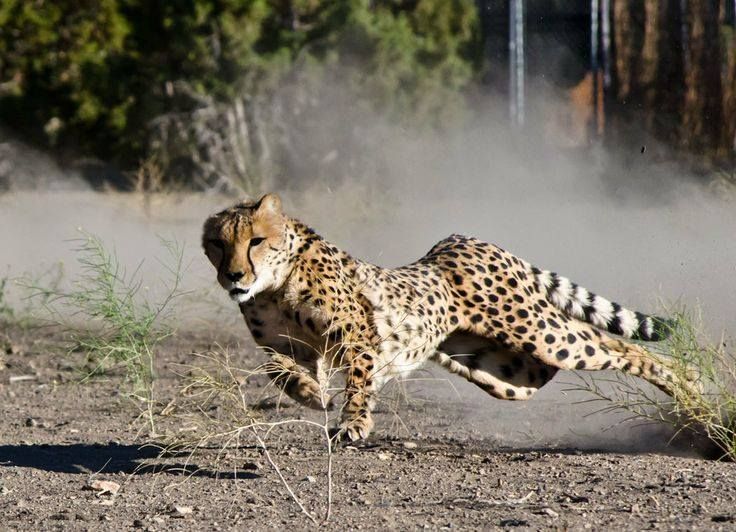 Such an acceleration in heart rate is impossible to maintain, and the spotted cat can quickly overheat and become winded.
Such an acceleration in heart rate is impossible to maintain, and the spotted cat can quickly overheat and become winded.
Running for longer than 30 seconds puts the cheetah perilously close to getting brain damage.
The exhaustion from sprinting is just as bad – a savannah is a dangerous place for any 60 kg animal without the strength to run.
Although the savannah is open, a cheetah must catch their prey within 700-1000 meters. So, they must still use stealth.
Here’s what happens if you’re lucky enough to spot a predatory cheetah during a safari:
Dipping its neck with ruthless precision, a cheetah disappears below the grass line.
The camouflage is magnificent.
Even from a safari truck, you can hardly see the cat. It’s glimpsed fleetingly, perhaps a flicker of a tail is all you can see.
Up ahead a herd of impala is grazing. Sentinels open their ears, scanning for danger.
Sentinels open their ears, scanning for danger.
You can sense the antelope are fearful, but nobody knows where the cheetah has gone.
Scanning around, you look again, noticing how the cheetah’s slender frame is very helpful when it needs to disappear.
Ideally, the predatory cat will get close enough to pounce within a few strides. However, that’s unlikely on such open plains. So it aims to reach its target within a few strides, where it can begin the chase.
Silence. Nothing is happening. You can’t find the cheetah and the impala are happily grazing.
Then out of nowhere comes chaos. Dust rises. Hooves sound like a drum roll as the impala scatter.
Accelerating to full speed, the cheetah runs, a blur of fur chasing a small impala.
How do you outrun the world’s fastest animal?
Zigzags.
By changing direction, the impala hopes to negate its speed disadvantage.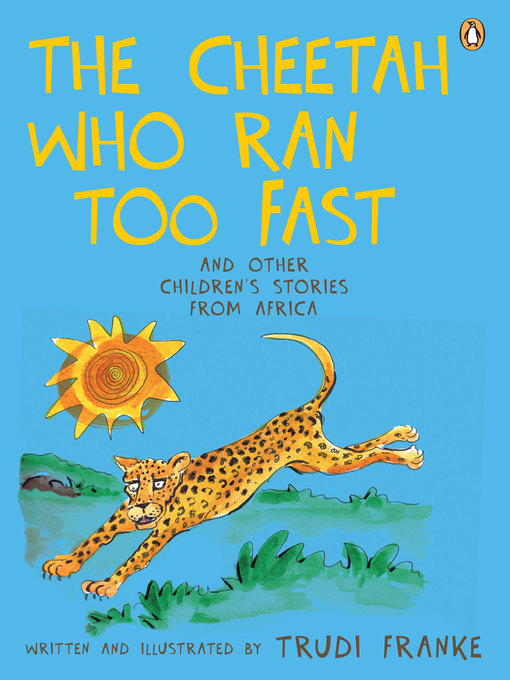 But when watching a cheetah run, you’ll appreciate just how well it can use its tail as a steering rudder.
But when watching a cheetah run, you’ll appreciate just how well it can use its tail as a steering rudder.
It’s unlikely you will ever see the kill up close. Once the cheetah runs, your safari vehicle won’t be able to keep up. However, many safari-goers experience the immediate aftermath of a hunt.
Lions and leopards typically pounce onto their prey from behind, biting at the neck.
Cheetahs don’t have that kind of strength.
Plus, jumping on the back of anything at 113 kph is risky. So instead, they trip their fast-moving prey.
Every attempt to trip up the impala will cost the cheetah vital fractions of a second. It will only have one or two chances to make this crucial move.
When the impala hits the ground, the cheetah pounces. It’s a quick and efficient kill. Exhausted and probably elated, the hunter has its quarry. But it’s not over yet.
Cheetahs are unable to eat their prey straight away – they’re just too worn out from the running. Unless they can hide their kill immediately, it becomes vulnerable to scavengers and bigger cats.
Unless they can hide their kill immediately, it becomes vulnerable to scavengers and bigger cats.
From a safari vehicle, you might watch a cheetah carrying its prey into the high grass. Or even the resonant sound of teeth cracking into bone.
Witnessing a cheetah running fast is a rare sight. It’s more likely you will encounter cheetahs when they are resting.
You can hear them purring and chirping, just one of many beautiful moments when you’re on an African safari.
Cheetah evolved on vast plains and open savannah across large parts of Africa and also Iran.
These landscapes offer lots of open space, meaning there is always somewhere to run.
But open plains aren’t easy for the top predators in Africa. There is limited cover, so it’s difficult to ambush prey.
Over many millennia the cheetah has adapted to hunt on these arid, open landscapes.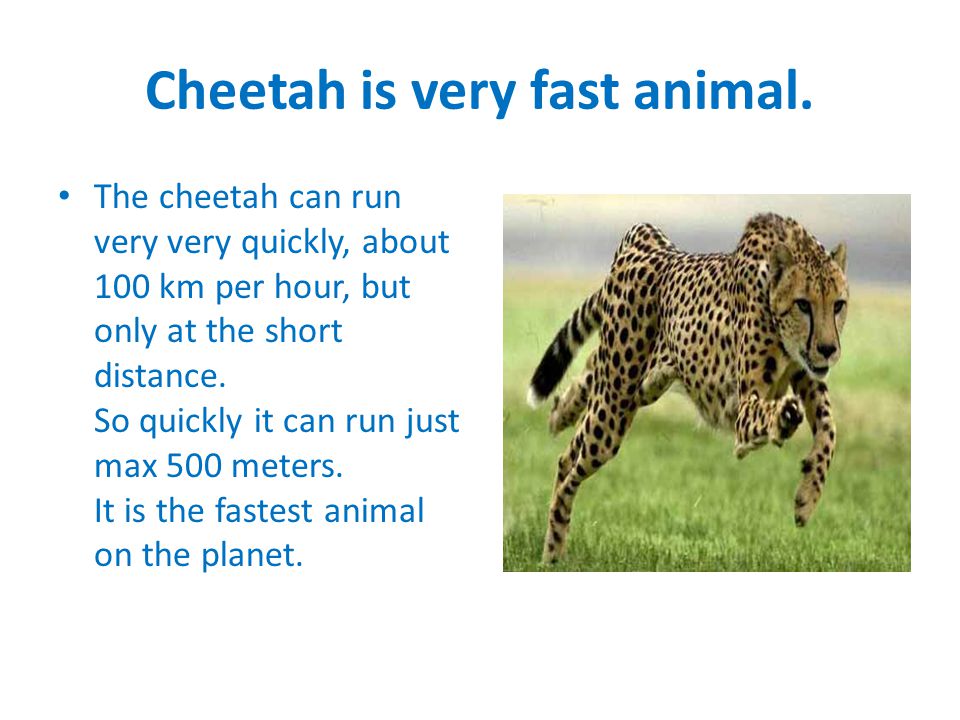
Their prey is small and nimble, typically impala, Thomson’s gazelle, wildebeest calf, plus a variety of antelope species of which the young and sick are targeted.
A cheetah’s choice of prey is lightweight and agile. These animals typically graze in herds, on landscapes away from trees and hiding places.
By sticking together, they can always scan for danger. These animals trust their speed when running away from predators.
Lions evolved with fearsome power and a group-based predatory instinct.
Leopards have incredible strength and stealth, allowing them to hunt prey far larger than themselves.
Cheetahs have evolved to run fast, so they can chase and catch their choice of prey.
If you’ve never been on an African safari, it’s easy to mistake leopards and cheetahs. Even on a safari, this can be difficult because it’s extremely rare to ever see these two animals side by side.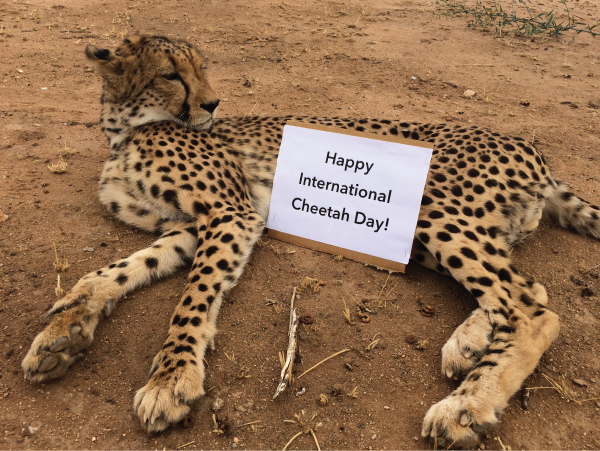
Both these predators are secretive cats who will avoid confrontation. Leopards are more commonly found residing in trees, while cheetahs are usually seen in the grass.
It’s terrible to take any animal captive and force them to live inside a cage. But the fastest animal of all? Cheetahs need space to run so it makes no sense to have them at a zoo.
These animals are born to run and have evolved exactly for that purpose. Unfortunately, in the not too distant future, it may only be possible to view cheetahs in zoos.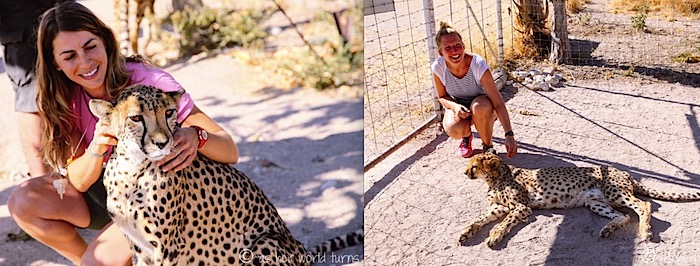
This remarkable animal has lost 91% of its historical range. Cheetahs are close to extinction, with less than 7000 of them remaining in the wild, and that number is plummeting at a terrible rate.
Cheetahs are the most specialized and evolved of all the big cats. Unfortunately, this has left them highly susceptible to habitat loss and habitat fragmentation.
This species could be an example of over-specialization. By making such extreme adaptations for a sole purpose (speed), cheetahs no longer have the diverse skills necessary to thrive in a changing environment.
Wide-open spaces are disappearing, and other cats can adapt to these changes.
For example, if a lion is forced into the forest it will still be an efficient hunter.
But if cheetahs can’t use their speed, they don’t have the strength or guile to hunt in alien conditions.
Less wilderness also means increased competition. More predators are found in close proximity, and cheetahs are unable to defend themselves, so they are forced into the outer reaches of a wilderness of a protected area.
Safari destinations with wide-open plains are best. The Serengeti and Masai Mara are obvious examples, although both Tanzania and Kenya have solid cheetah populations.
These sprinting cats are harder to encounter in Southern Africa. Zambia’s Liuwa Plain National Park and Botswana’s Central Kalahari or Okavango Delta should give you a good chance.
Less than 7000 is a harrowing figure, so you should get to Africa quickly while these incredible animals still remain in the wild.
A cheetah is one of the fastest creatures on Earth. Just how fast can a cheetah run? These majestic animals can hit top speeds of over 60 mph in a couple of strides. However, their numbers are dwindling in the wild.
However, their numbers are dwindling in the wild.
For a chance to see these incredibly fast animals in the wild, check out these African safari deals.
Cheetahs are the fastest land animal in the world! Just how fast can a cheetah run? What are their top speeds? In this post, you’ll learn their top and average speed, plus unique features that allow them to run so fast.
Table of Contents
Cheetahs are capable of running an amazing top speed of 76 mph (122 km/h)! But this is only sustainable for a short sprint (1480 feet). And this speed is only a calculated speed.
Cheetahs average speed is just 40 mph (64 km/h) but can quickly accelerate to it’s top speed.
The fastest recorded speed was by a cheetah named Sarah. Sarah the cheetah was recorded doing a top speed of 61 mph (98 km/h) during a 100-meter dash while living at the Cincinnati Zoo in Ohio. Sadly, Sarah passed away in January 2016, at the old age of 15 (the average lifespan of a cheetah in the wild is 10-12 years).
Sarah the cheetah was recorded doing a top speed of 61 mph (98 km/h) during a 100-meter dash while living at the Cincinnati Zoo in Ohio. Sadly, Sarah passed away in January 2016, at the old age of 15 (the average lifespan of a cheetah in the wild is 10-12 years).
Cheetahs (Acinonyx jubatus) are built for speed. They have been compared to greyhounds in terms of similar builds.
Here are 6 reasons they are the fastest land animal:
 You can’t go fast if you can’t stay on your feet!
You can’t go fast if you can’t stay on your feet! For all these reasons, then, it’s no wonder cheetahs are the fastest land animal on the earth!
Cheetahs can’t maintain their top speed for very long. Cheetahs can run at top speed for around 0. 28 miles (0.45 kilometers). They are more sprinters than long-distance runners. And they can cover that distance in just 13 seconds at top speed.
28 miles (0.45 kilometers). They are more sprinters than long-distance runners. And they can cover that distance in just 13 seconds at top speed.
And cheetahs have an average running speed of 40 mph (64km/h).
Here’s how long a cheetah can run at top speeds. And how long it would take to cover the same distance at their average speed.
And here are the same specs in metric.
Cheetahs can go from 0-60 mph (0-96.5km/h) in about 3 seconds! Cheetahs can accelerate very quickly.
This is a similar 0-60 time as the Ford GT, a USD$500,000 supercar. In fact, a cheetah’s acceleration time means it measures well compared to with world’s fastest cars.
(To be honest, I would rather a supercar than a cheetah. But hey, that’s just me.)
Just as impressive as their straight-line speed, cheetahs can also decelerate quickly. They can go from around 60 mph (97 km/h) to 14 mph (23 km/h) in three strides.
Now that we’ve compared the cheetah to supercars, how do they stack up against other big cats? Let’s find out. The following are 8 of the fastest wild cats in the world and their top speeds:
All are fast and majestic, and can easily outrun a human.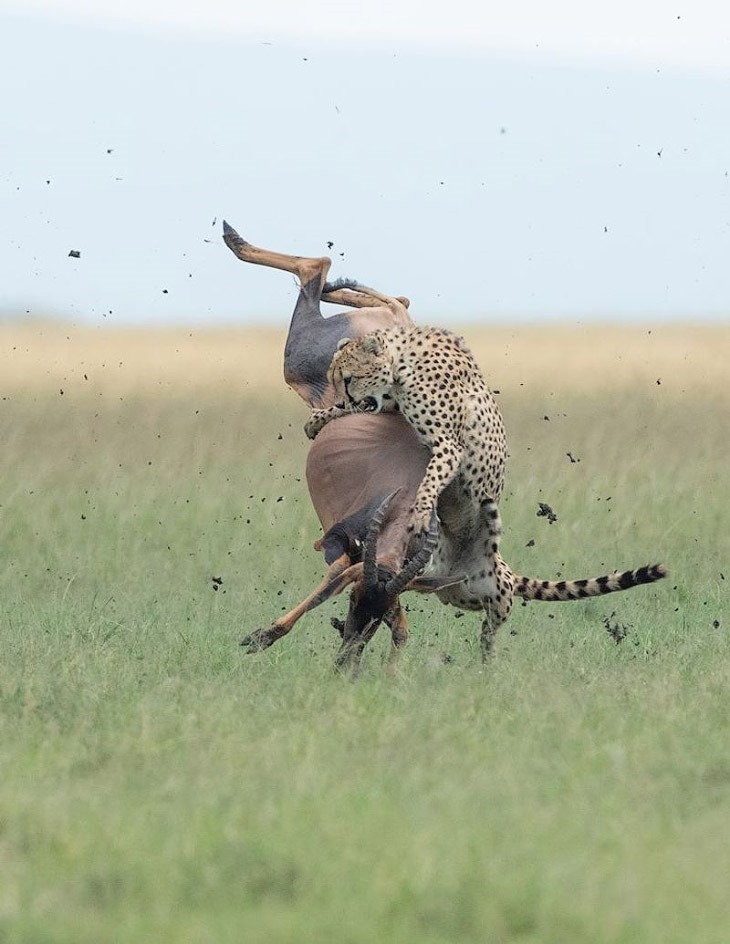 However, none of them can catch the cheetah’s either calculated top speed, or their recorded one.
However, none of them can catch the cheetah’s either calculated top speed, or their recorded one.
Cheetahs are hunters. They use their speed to catch their prey. Cheetahs hunt small to medium prey, usually less than 88 pounds (40 kilograms). Larger prey are often avoided, and if cheetahs do attack a bigger target, they will generally do so in groups.
To escape: However, cheetahs are also among the smaller of the big cats, built for speed and less for power. Thus, they can be bullied from their kills. Lions, leopards, and hyenas can take their prey away from cheetahs. So, cheetahs have to eat their prey quickly, or else they have to use their speed for another reason, to escape.
Cheetahs will stalk their prey, often within 200-230 feet (60-70 meters). Cheetahs will also lay in wait for the prey to come nearer. If there isn’t any cover, then cheetahs will approach within 660 feet (220 meters), then spring their attack.
The chase usually lasts a minute, and cheetahs may give up they chase if they get detected by their prey or if they can’t kill their target quickly.
To catch the animal, cheetahs will try to trip their prey either with their dewclaw or by swatting at its rump. This may break the bones of the prospective meal, making it easier for cheetahs to catch it.
After catching their prey, cheetahs will bite at the prey’s neck to suffocate it, holding on for around 5 minutes. Smaller prey may die from the bite itself.
Often, cheetahs will hunt during the daytime, usually around dawn (between 6am to 10 am) and dusk (between 4pm and 6 pm).
Cheetahs tend to avoid when other bigger creatures hunt, like lions (who primarily hunt at night). This makes sense, as they can avoid any confrontation with bigger and more powerful predators.
Cheetahs will hunt medium-sized ungulates, depending on the area. Cheetahs may prey on livestock as well. Their prey is often fast themselves, with gazelles and springboks able to get to speeds of 60 mph (96 km/h) and 55 mph respectively.
Cheetahs may prey on livestock as well. Their prey is often fast themselves, with gazelles and springboks able to get to speeds of 60 mph (96 km/h) and 55 mph respectively.
Here are some of the cheetahs favorite prey: gazelles, springboks, impalas, and other small antelope.
Read more about the zebras top running speed.
The success rate cheetahs have with their hunts is 25 to 40 percent. If their prey is smaller, then it may be higher.
Cheetahs expend a lot of energy with their running. After the hunt is over and their food is caught, cheetahs may rest for up to an hour after dragging their kill to a tree or a bush.
Running that hard can tire anyone or anything out, so cheetahs can be found panting quite heavily after a run.
Learn about cheetah cubs: 14 Cute Baby Cheetah Facts
The quick answer is that cheetahs can outrun humans by a lot.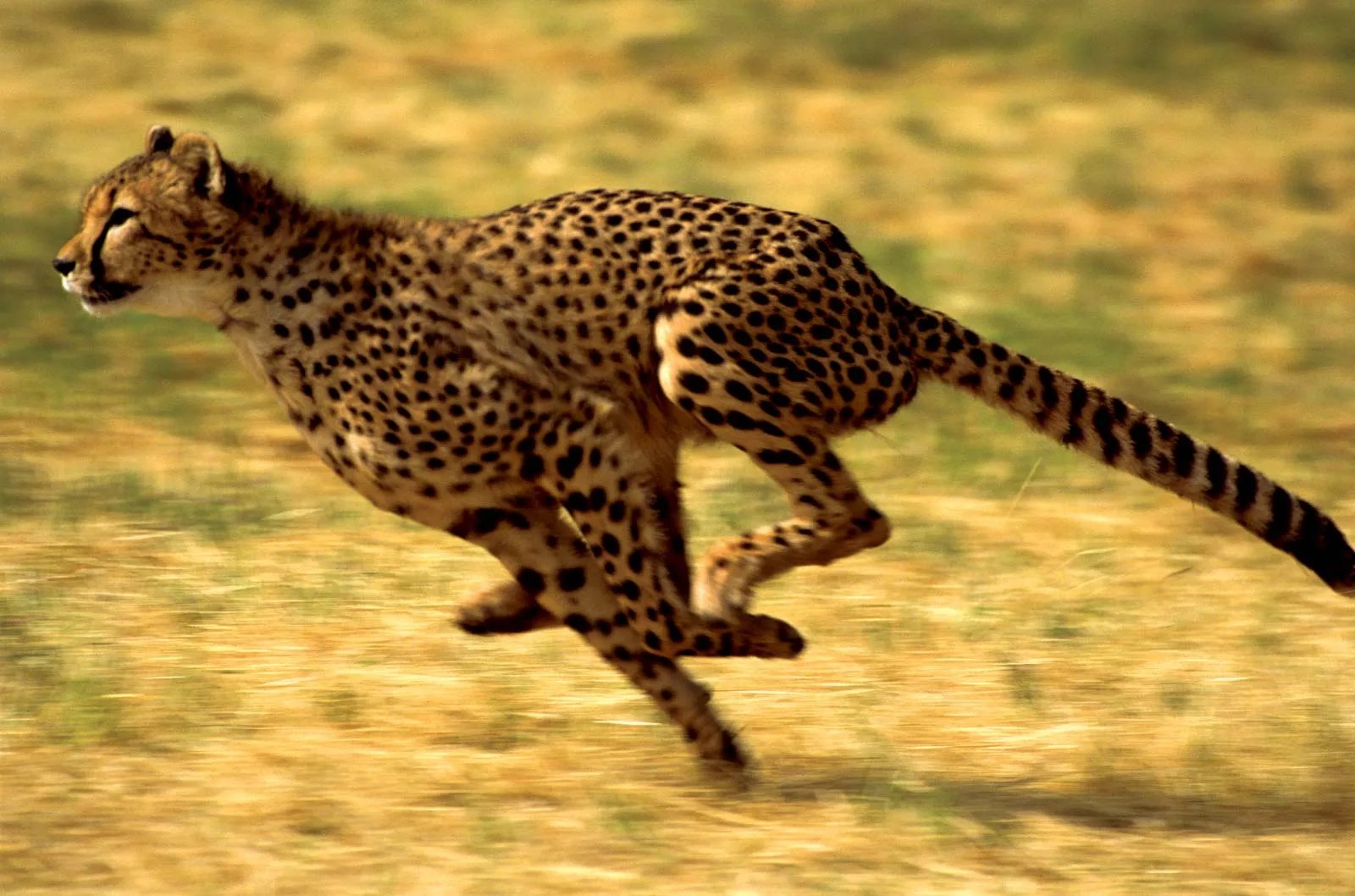 Sarah the cheetah, mentioned earlier, did the 100-meter dash in 5.95 seconds, destroying Usain Bolt’s 100-meter record time of 9.58 seconds.
Sarah the cheetah, mentioned earlier, did the 100-meter dash in 5.95 seconds, destroying Usain Bolt’s 100-meter record time of 9.58 seconds.
The average man can run 5.9 mph (9.5 km/h). At this speed, it would take the average man 38 seconds to run 100 meters, verses a cheetahs 5.95 seconds.
There have not been many documented cases of a cheetah attacking a human. When an incident does happen, it’s usually because of an aggravated cheetah in captivity. In fact, they’re quite docile compared to other big cats. Cheetahs have also been known to purr!
Cheetahs have been tamed and kept as pets, and humans have done so for thousands of years. In fact, there are cheetah experiences in zoos around the world today where you can go pet and play with these lovable big cats.
Still, cheetahs don’t do well in captivity. In 2014, 23 percent of cheetahs in captivity around the world died before they reached the one-year-old mark.
More reading: Cheetah vs Leopard: 14 Key Differences
Keep Reading: 21 King Cheetah Facts
What do you think about cheetahs? Ever hear one purr? Is there anything we missed? Let us know in the comments below!
Joshua Diegor
Hello, I’m Joshua Diegor. My love for travel began I was 18 when I went with some friends to New York City. All in all, I’ve traveled to 6 continents and 14 countries.
I’m a regular contributor to Storyteller Travel.
Running Cheetah Photo: Fotolia/photobar
Vladimir FradkinJuly 1, 2013
for a long time. It was believed that speed is the trump card of this predator on the hunt. But now British scientists have found that everything is much more complicated.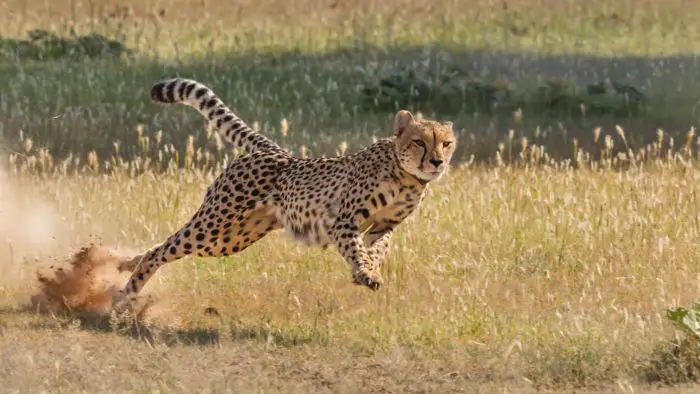
https://www.dw.com/ru/%D0%B3%D0%B5%D0%BF%D0%B0%D1%80%D0%B4-%D1%87%D0%B5%D0% BC%D0%BF%D0%B8%D0%BE%D0%BD-%D0%BC%D0%B8%D1%80%D0%B0-%D0%BF%D0%BE-%D1%82%D0 %BE%D1%80%D0%BC%D0%BE%D0%B6%D0%B5%D0%BD%D0%B8%D1%8E/a-16913493
Advertising
The cheetah is the fastest land animal on our planet. This predator is capable of reaching speeds of more than one hundred kilometers per hour, and it takes two seconds to accelerate from 0 to 75 kilometers per hour. Not every sports car can boast of such indicators. No greyhound dogs, no sports horses can keep up with cheetahs (and you can’t run away from cheetahs). Therefore, until now, zoologists have proceeded from the belief that it is precisely such an incredible running speed that is the main advantage of the cheetah on the hunt. However, strictly scientific verification, especially in the wild, this hypothesis has never been subjected. And in general, scientists knew little about the athletic abilities of these representatives of the cat family, with the exception of sprinting.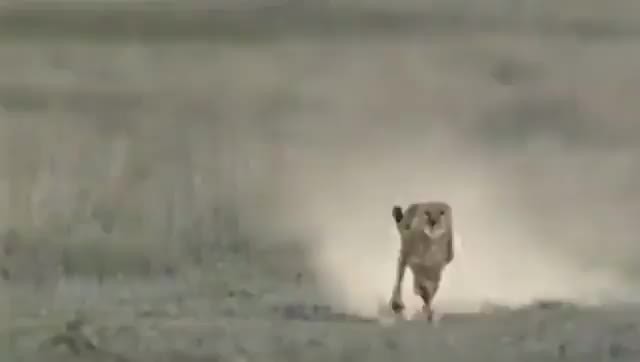
High tech collars
And now British researchers have filled this gap. Alan Wilson, a professor at the Royal Veterinary College at Hatfield, and a group of his colleagues went to the southern African continent, to Botswana, captured five cheetahs east of the Okavango Delta and put special high-tech collars on them. “These collars are the result of a development that took us ten years,” explains Professor Wilson. “We managed to integrate a lot of sensors into them. These are GPS sensors, and inertia meters, and acceleration sensors, and gyroscopes, and magnetometers, so track the spatial position of the cheetah's body in real time.We measure all these parameters 300 times per second, so we know the location of the animal at any time, and the direction of its movement, and speed.Using these parameters, you can calculate what power the beast develops, and what is the adhesion of its paws to the ground, and in general what forces act there.
The main thing is not speed, but maneuverability
The researchers monitored the movements of "their" cheetahs from a car and from a light aircraft. Previously, special radio receivers were installed in these vehicles, which recorded the signals sent by miracle collars.
Previously, special radio receivers were installed in these vehicles, which recorded the signals sent by miracle collars.
Such an observation, which lasted 17 months, made it possible to learn a lot of new, interesting and even unexpected things about the behavior, hunting techniques and physical capabilities of cheetahs. The results of the work are published in the journal Nature. Professor Wilson says: "To our amazement, it turned out that in the wild, cheetahs did not hunt at maximum speed at all. Although they did sometimes develop speeds in excess of 90 kilometers per hour, but only at very short distances, on average 173 meters long, only for a very short time, on average 1-2 seconds, and only very rarely, 1-2 times a day. The average running speed of cheetahs on the hunt is a little more than 50 kilometers per hour. Obviously, it is much more important for them not speed in a straight line, but agility, maneuverability, the ability to instantly change direction, accelerate movement and slow down. "
"
Better ground grip than tires
Indeed, cheetahs not only accelerate faster than all other terrestrial animals, but also slow down more sharply than anyone else, twice surpassing the second-best polo ponies in this indicator - specially trained horses for playing polo. If the maximum acceleration of a cheetah, measured by British scientists, is 5.5 meters per second squared, then the maximum deceleration is 7.5 meters per second squared. One of the tools that provide cheetahs with this ability is their claws: they are only partially retractable, which is not typical for cats, and provide reliable contact with the ground during sharp maneuvers.
“In addition, cheetahs have an extremely flexible spine, which allows them to properly distribute the load on the body, so that even with the most inconceivable turns and turns, all four paws touch the ground,” says Professor Wilson. of any car tire. And, of course, muscles play a very important role: the muscles of the cheetah's paws, which, by the way, make up 45 percent of the mass of its entire body, have incredible strength.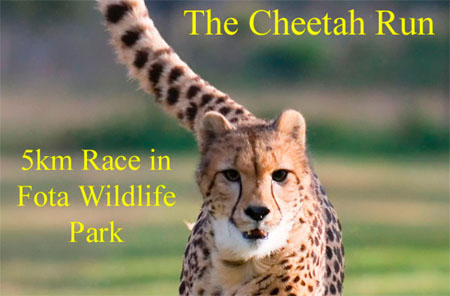 The fastest of "our" cheetahs developed power at the moment of maximum acceleration up to 100 watts per kilogram of body weight. For comparison: the Jamaican athlete Usain Bolt, multiple Olympic champion and world champion in sprinting, this figure is four times more modest. "
The fastest of "our" cheetahs developed power at the moment of maximum acceleration up to 100 watts per kilogram of body weight. For comparison: the Jamaican athlete Usain Bolt, multiple Olympic champion and world champion in sprinting, this figure is four times more modest. "
Only a quarter of the chase brings success
Another surprise came from the comparison of the GPS data obtained using the collars with the data from the geographic information system Google Earth. It turned out that cheetahs hunt not only in open areas, as was previously thought, but also in dense bushes. There, for sure, for success they need not speed, but agility. And sprint records are just one element of their hunting strategy.
However, we should not forget that success accompanies cheetahs only in every fourth pursuit of prey, that is, three times out of four the predator is left with nothing. And this is the other side of his sprint achievements: with a maximum speed of over 9At 0 kilometers per hour, the minimum turning radius of a cheetah, at which centrifugal force would not throw it out of the turn, is 52 meters. And even at half the speed, this radius is still unacceptably large - almost 20 meters. This is where the predator needs his ability to brake sharply: in just three steps, he can slow down so much that the turning radius is reduced to one meter.
And even at half the speed, this radius is still unacceptably large - almost 20 meters. This is where the predator needs his ability to brake sharply: in just three steps, he can slow down so much that the turning radius is reduced to one meter.
Write to Editor
Advertisement
Skip Section Top Topic1 Page of 3
Skip Section Other Publications DWHome Page
Subscribe to our Newsletters
Copyright © iStock
What do we know about cheetahs? These graceful big cats run very fast, have fluffy babies, and are in danger of extinction. Today, BBC Earth columnist brings readers five lesser-known facts about cheetahs that might surprise you.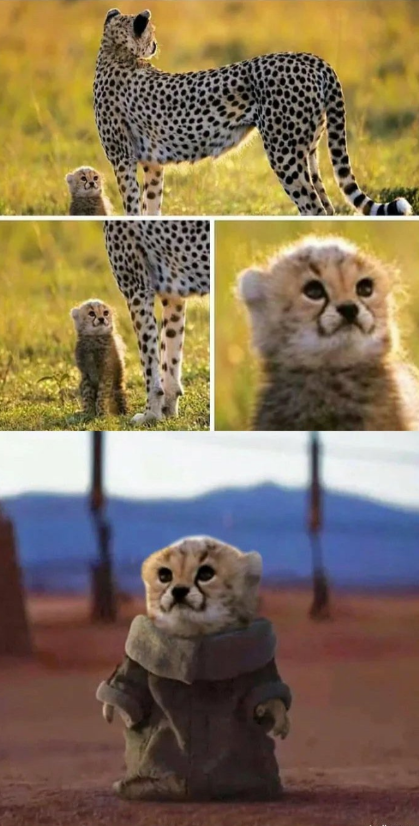
Imagine a running cheetah and your imagination will surely take you to the African savannah.
However, one small population of a subspecies of these wonderful cats lives on hard-to-reach plateaus in central Iran. This is an Asiatic cheetah.
Once its range covered India, Pakistan, Russia and the countries of the Middle East, but now only 60-100 individuals of this subspecies remain in the world.
Asiatic cheetahs (Acinonyx jubatus venaticus) have smaller heads, shorter limbs, denser coats and thicker necks than their African counterparts. They also surprised scientists with their ability to travel very long distances within their habitat.
Image Credit, iStock
Cheetah cubs have a hard time growing up. Precise mortality data are available in only a few studies, but suggest that mortality rates are extremely high, especially among pups born in the Serengeti region of East Africa.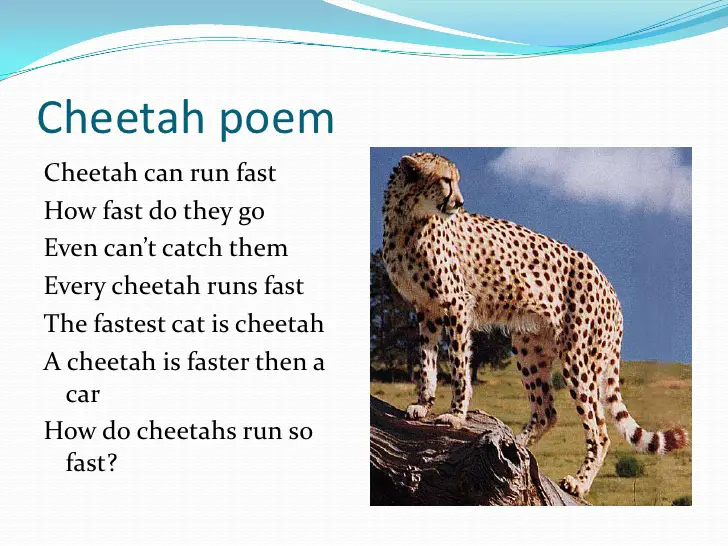
In one study conducted in the 1990s, 95% of the Serengeti cubs observed by scientists died before reaching puberty.
Another study published in 2013 also concluded that very few cheetah cubs survive in this region.
However, the same study showed that cheetahs living in the Kgalagadi Transfrontier Park in southern Africa have a much higher chance of surviving to sexual maturity, about 36%.
Most often they die from the teeth of lions, but they are also hunted by other representatives of the local fauna - hyenas, baboons and birds of prey.
Disease and (are you surprised?) human activities contribute to animal mortality. Sad but true: the illegal trade in cheetah cubs thrives in the Persian Gulf countries.
It is very fashionable to keep such exotic pets here - on the black market, their price reaches 10,000 US dollars. This is another factor that has an extremely negative impact on the abundance of the species.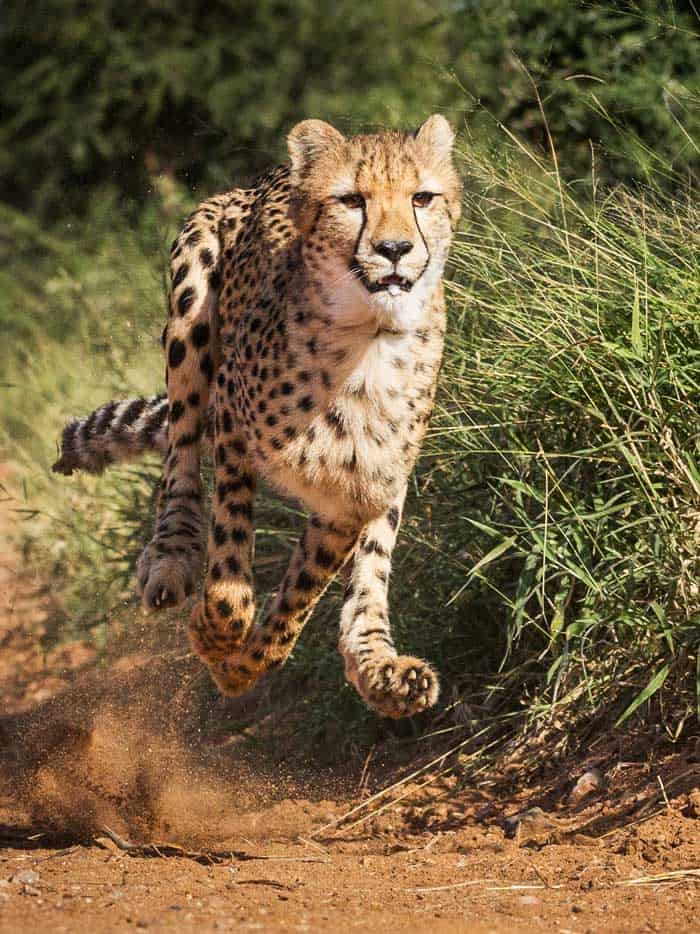
Image Credit, iStock
Cheetahs are very fast. Their exact speed is a matter of debate, but a BBC Earth reviewer did a bit of research and found that the fastest recorded speed of this beast is 96 km/h.
That's twice as fast as Usain Bolt, who broke the world record in the 100-meter sprint with a speed of 44.7 km/h.
It's hard to believe, but when the cheetah reaches its maximum speed, the length of its jump reaches 7 m, and more than half of its time it spends in the air.
In addition, the cheetah can accelerate from 0 to 97 km/h in three seconds, faster than many sports cars.
This is largely due to the fact that cheetahs have mobile hip and shoulder joints and a flexible spine.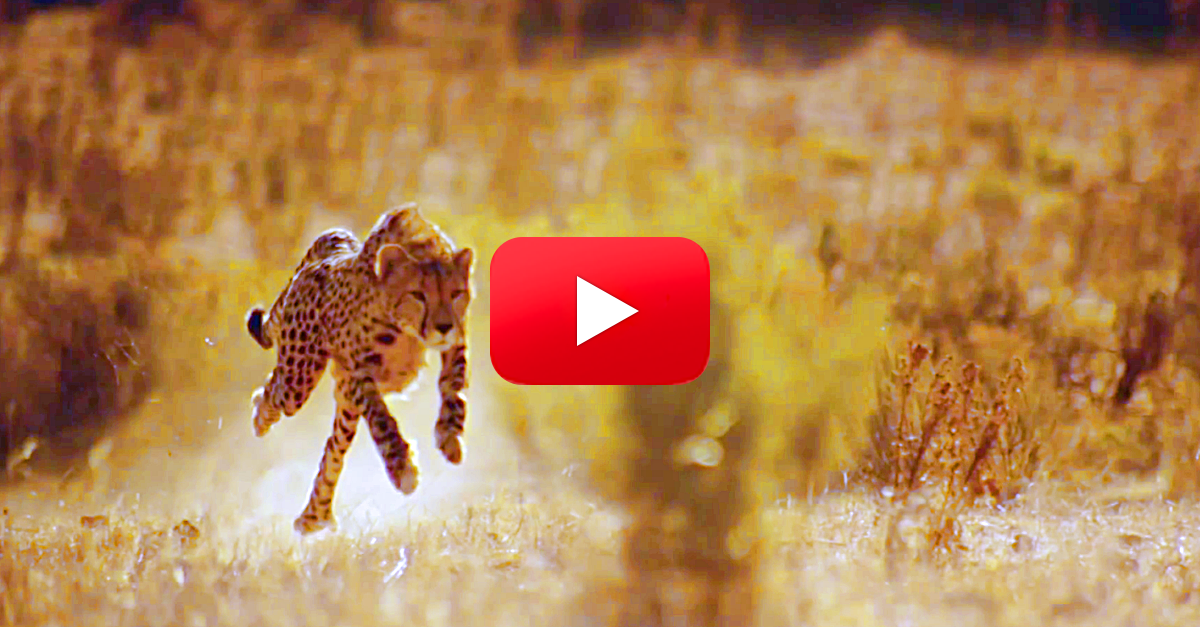
At the same time, they can only move at this speed in short bursts, which means that they only have about 20 seconds to overtake their prey.
Image Credit, iStock
Cheetahs are not your typical big cats. Speed is undoubtedly their most powerful weapon, but some of what we used to associate with large cats, they do not know how to do.
For example, cheetahs do not roar, but they can purr, chirp like birds, hiss and even bark.
Surprisingly, they see no better in the dark than we do. And in general, cheetahs are diurnal animals, preferring to hunt in the early morning or on the slope of the day.
They are bad at climbing trees (see the video in the original of this article in English).
Image copyright iStock
Female cheetahs have to cope with the incredibly difficult task of raising all their cubs alone, which can number up to nine in one litter.